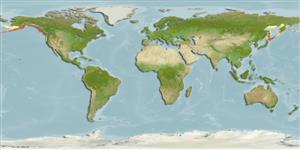Environment: milieu / climate zone / profondeur / distribution range
Écologie
marin démersal; profondeur ? - 91 m (Ref. 2850). Temperate
North Pacific: Kamchatka, Russia through the Aleutian chain and the Bering Sea to the Bering Strait coasts of Alaska and Humboldt Bay, California, USA.
Taille / Poids / Âge
Maturité: Lm ? range ? - ? cm
Max length : 42.0 cm TL mâle / non sexé; (Ref. 2850)
Description synthétique
Clés d'identification | Morphologie | Morphométrie
Épines dorsales (Total) : 61 - 62; Rayons mous dorsaux (Total) : 0; Épines anales: 1; Rayons mous anaux: 44 - 51. Caudal rounded (Ref. 6885). Pale brown with white to cream markings, paler below; irregular light areas on upper part of body, and vertical light bars below; dark bars run down from eyes; prominent dark bars on the dorsal, caudal and anal fins (Ref. 6885).
Usually among seaweed on rocky bottoms (Ref. 2850); in reef crevices, usually among algae (Ref. 51666). Occurs in subtidal areas to 91 m depth (Ref. 2850).
Life cycle and mating behavior
Maturité | Reproduction | Frai | Œufs | Fécondité | Larves
Eschmeyer, W.N., E.S. Herald and H. Hammann, 1983. A field guide to Pacific coast fishes of North America. Boston (MA, USA): Houghton Mifflin Company. xii+336 p. (Ref. 2850)
Statut dans la liste rouge de l'IUCN (Ref. 130435: Version 2025-1)
Menace pour l'homme
Harmless
Utilisations par l'homme
Pêcheries: commercial; Aquarium: Aquariums publics
Outils
Articles particuliers
Télécharger en XML
Sources Internet
Estimates based on models
Preferred temperature (Réf.
123201): 4.1 - 10.4, mean 8 °C (based on 180 cells).
Phylogenetic diversity index (Réf.
82804): PD
50 = 0.5039 [Uniqueness, from 0.5 = low to 2.0 = high].
Bayesian length-weight: a=0.00372 (0.00145 - 0.00954), b=3.17 (2.94 - 3.40), in cm total length, based on LWR estimates for this (Sub)family-body shape (Ref.
93245).
Niveau trophique (Réf.
69278): 3.6 ±0.5 se; based on size and trophs of closest relatives
Résilience (Réf.
120179): Très faible, temps minimum de doublement de population supérieur à 14 ans (Preliminary K or Fecundity.).
Fishing Vulnerability (Ref.
59153): Low to moderate vulnerability (32 of 100).
🛈
